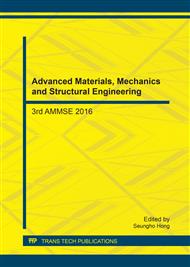[1]
J. Banhart, Manufacture, characterisation and application of cellular metals and metal foams, Prog. Mater. Sci. 46(6) (2001) 559-563.
DOI: 10.1016/s0079-6425(00)00002-5
Google Scholar
[2]
L. J. Gibson, M. F. Ashby, Cellular Solids: Structure and Properties, second ed., Cambridge University Press, Cambridge, UK, (1997).
Google Scholar
[3]
B. H. Smith, S. Szyniszewski, J. F. Hajjar, et al., Steel foam for structures: A review of applications, manufacturing and material properties, J. Constr. Steel Res. 71 (2012) 1-10.
DOI: 10.1016/j.jcsr.2011.10.028
Google Scholar
[4]
M. F. Ashby, A. Evans, N. A. Fleck, et al., Metal Foams: A Design Guide, Elsevier Science, Boston, MA, (2000).
Google Scholar
[5]
N. Bekoz, E. Oktay, High temperature mechanical properties of low alloy steel foams produced by powder metallurgy, Mater. Des. 53 (2014) 482-489.
DOI: 10.1016/j.matdes.2013.07.050
Google Scholar
[6]
N. Bekoz, E. Oktay, Effects of carbamide shape and content on processing and properties of steel foams, J. Mater. Process. Technol. 212(10) (2012) 2109-2116.
DOI: 10.1016/j.jmatprotec.2012.05.015
Google Scholar
[7]
N. Bekoz, E. Oktay, Mechanical properties of low alloy steel foams: Dependency on porosity and pore size, Sci. Eng. A 576 (2013) 82-90.
DOI: 10.1016/j.msea.2013.04.009
Google Scholar
[8]
M. Bram, C. Stiller, H. P. Buchkremer, et al., High-Porosity Titanium, Stainless Steel, and Superalloy Parts, Adv. Eng. Mater. 2(4) (2000) 196-199.
DOI: 10.1002/(sici)1527-2648(200004)2:4<196::aid-adem196>3.0.co;2-k
Google Scholar
[9]
Y. M. Z. Ahmed, B. A. Iskander, M. Ibrahim, et al., Mechanical properties and porosity relationship of porous iron compacts, Powder Metall. 52(1) (2009) 72-79.
DOI: 10.1179/174329008x315584
Google Scholar
[10]
Z. Esen, Ş. Bor, Processing of titanium foams using magnesium spacer particles, Scr. Mater. 56(5) (2007) 341-344.
DOI: 10.1016/j.scriptamat.2006.11.010
Google Scholar
[11]
N. Michailidis, F. Stergioudi, A. Tsouknidas, et al., Compressive response of Al-foams produced via a powder sintering process based on a leachable space-holder material, Mater. Sci. Eng. A 528(3) (2011) 1662-1667.
DOI: 10.1016/j.msea.2010.10.088
Google Scholar
[12]
A. Laptev, M. Bram, H. P. Buchkremer, et al., Study of production route for titanium parts combining very high porosity and complex shape, Powder Metall. 47(1) (2004) 85-92.
DOI: 10.1179/003258904225015536
Google Scholar
[13]
Z. Esen, Ş. Bor, Characterization of Ti–6Al–4V alloy foams synthesized by space holder technique, Mater. Sci. Eng. A 528(7-8) (2011) 3200-3209.
DOI: 10.1016/j.msea.2011.01.008
Google Scholar
[14]
N. Bekoz, E. Oktay, The role of pore wall microstructure and micropores on the mechanical properties of Cu–Ni–Mo based steel foams, Mater. Sci. Eng. A 612 (2014) 387-397.
DOI: 10.1016/j.msea.2014.06.064
Google Scholar
[15]
B. Wang, E. Zhang, On the compressive behavior of sintered porous coppers with low-to-medium porosities-Part II: Preparation and microstructure, Int. J. Mech. Sci, 50(3) (2008) 550-558.
DOI: 10.1016/j.ijmecsci.2007.08.003
Google Scholar
[16]
I. Oh, N. Nomura, N. Masahashi, et al., Mechanical properties of porous titanium compacts prepared by powder sintering, Scripta Mater. 49(12) (2003) 1197-1202.
DOI: 10.1016/j.scriptamat.2003.08.018
Google Scholar
[17]
D. P. Mondal, H. Jain, S. Das, et al., Stainless steel foams made through powder metallurgy route using NH4HCO3 as space holder, Mater. Des. 88 (2015) 430-437.
DOI: 10.1016/j.matdes.2015.09.020
Google Scholar
[18]
C. Park, S. R. Nutt, Anisotropy and strain localization in steel foam, Mater. Sci. Eng. A 299(1-2) (2001) 68-74.
Google Scholar


